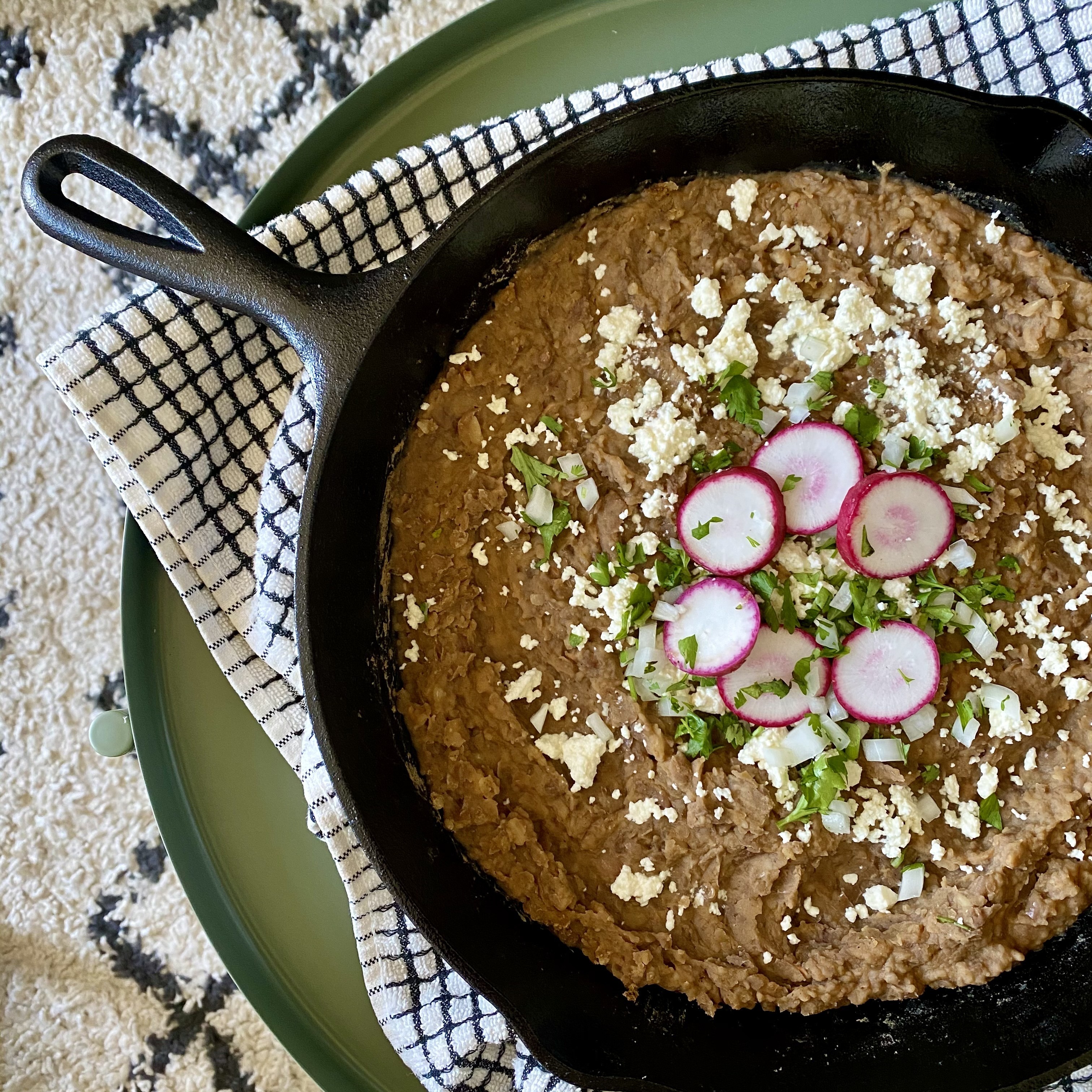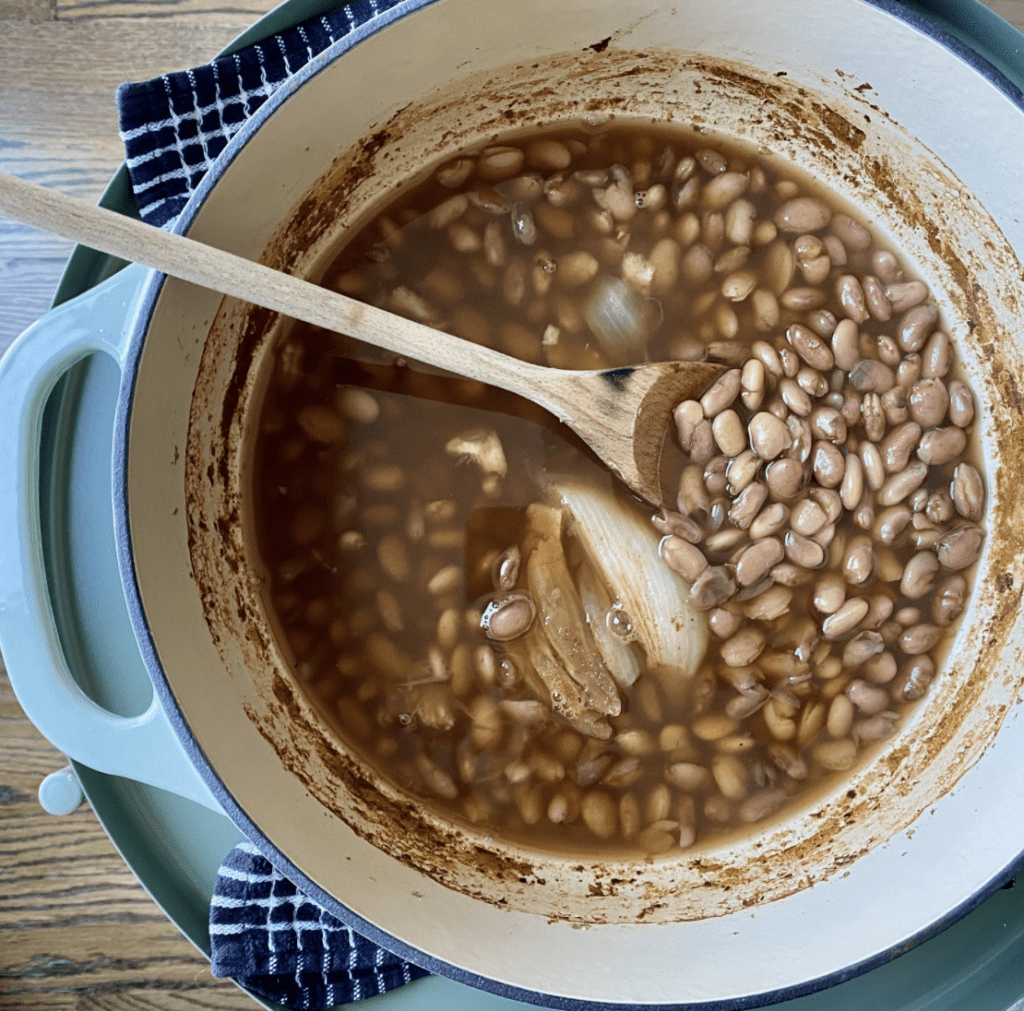
Historias de la Cocina: Refried Beans
The Mexican staple is a dizzy mix of pop culture meme and slave trade history.
Why are Mexican home cooks always in panic over their beans? The TikTok trend that shows Mexican folks going about daily activities, before tripping over themselves in realization that the frijoles are burning, is a lighthearted nod to how frijoles, or beans, are almost always cooking in Mexican households. But a simmering pot of beans can take hours to fully cook, leaving plenty of time to forget it’s even sitting on the stove. I often find myself neglecting my pot until the smell of crispy frijoles demands I make a mad dash to the kitchen to add more water to the pot.
Beans, especially the pinto variety, are crucial to Mexican cuisine. Stewed over a few hours, pinto beans can be served whole and fried (frijoles chinos) or mashed and refried (frijoles refritos). Frijoles are eaten with almost every main course alongside arroz. In many Mexican restaurants in America, refried beans are served with a layer of melty, gooey, shredded cheese on top. This is a style characteristic to the Southwestern United States, especially at restaurants specializing in Tex-Mex cuisine. In Mexico, as well as in more traditional Mexican-American restaurants and households, frijoles refritos may be garnished with queso fresco.
Whole and fried beans, or frijoles chinos, are the first step to making refried beans. The stewed beans are heated in fat, usually lard or leftover bacon grease, until they begin to crisp on the outside. The name for this simple method of preparation, however, has a turbulent history rooted in the African slave trade in Mexico. Historically, frijoles chinos may have been named as such for the way the bean consistency resembled the curly texture of African slave’s hair in the 16th and 17th centuries. This history is important for Mexican culture, as it helps Mexican people reckon with the country’s involvement in the slave trade. It’s also a way to study how connotations of certain words still hold tinges of colorism in present day Spanish.
Understanding frijoles chinos requires an understanding of linguistic history of the Spanish word “chino.” From the late 16th to the 18th century, Mexican colonial documents often mistranslated “chino” to “Chinese.” In the Journal of Pan African Studies, Professor of Spanish, Marco Polo Hernández Cuevas, discusses the term and its history, stating that generally, “chinos” were Afro-Mexican “chinos-cambujos” or biracial people. Cuevas goes on to say that in New Spain archival records, the term “Chino” was used by Spanish colonizers to refer to Mestizo, or mixed-race Mexicans whose blood was “tainted” by African blood. “Chino” is historically a synonym for pig in Murcia, Spain, and Cuevas says that while the term’s “animal connotation” is no longer used, the racist implication of the word still exists in Mexico. For example, curly hair may be described as pelo chino, and the slang word for nasty is cochino.
Additionally, the linguistic study of food terms helps reveal other misinterpretations of the Mexican dish names. The English term “refried beans” is also a mistranslation, this time of the Spanish term “frijoles refritos,” which translates more directly to “well-fried” beans. The beans aren’t actually fried twice — as suggested by the prefix “re” — but cooked, fried in fat (usually lard or bacon grease) and mashed with their cooking liquid until smooth.
Refried beans were an essential in my home and my grandparents’ home as I was growing up. On car rides home from elementary school, like every other kid, I’d ask my mom to stop for fast food for dinner and was instead met with a stern “we have food at home.” That food usually consisted of some version of a pot of leftover beans and tortillas. I used to joke that this was all my mom ever ate, but as I’ve gotten older, I’ve realized that refried beans in a tortilla tastes like pure comfort.
My mom was a working single mother of two, so she often didn’t have the time or energy to slow cook a sumptuous pot of frijoles. As a solution, my abuela cooked huge pots of the cafe-con-leche colored beans and brought them over, almost weekly. In the summers of my childhood, when I stayed longer stretches of time at her home, I’d help her with the frijoles. I was always tasked with sorting the individual beans. My abuela poured out huge bags onto the bare counter, telling me to pick out any rocks, sticks or broken bits.

Photo by Jae Taurina Thomas.
My grandma swears by Estancia pinto beans from New Mexico. She travels to Albuquerque twice a year, partly to visit family we have there, and partly to buy beans. She says that a 20-pound sack lasts her about six months. After I moved out of California for college, my abuela began mailing me boxes with gallon-sized Ziploc bags stuffed with beans. Despite the large variety of prepackaged beans at local stores, my grandma always says: “There’s nothing like New Mexico beans.”
Although they take multiple hours and require a heedful cook, plain dried beans become the epitome of savory when cooked low and slow with plenty of aromatics — something canned beans (especially ones from Goya) will never amount to. In addition, they can be stored well in the fridge for around a week or in the freezer for up to two months, offsetting all the cooking hours. You can also easily make them vegetarian by ditching the pork and frying in canola or vegetable oil instead of lard or bacon fat. And you can stop after frying the beans whole or mash them up for traditional frijoles refritos. If you plan on making the latter, be sure to use a scratch-resistant pan, like a good cast iron skillet, so your cookware comes out unharmed after mashing.
As always, don’t panic if you find yourself running to the kitchen to add more water to a sizzling pot of frijoles — even the most seasoned Mexican home cooks have been forgetting about beans on the stove for years.
Refried Beans
Yield: 4 cups
Time: 4 ½ hours plus 10 minutes for frying
Ingredients
- 2 cups dried pinto beans* (Estancia Valley Pintos, if you can find them)
- ¼ large yellow onion, skin taken off, left in one piece
- 3-4 large cloves of garlic, sliced in half lengthwise
- 1 tsp. cumin
- 1 tsp. oregano (preferably Mexican)
- ½ tsp. New Mexico red chile powder or other red chile powder
- 1 ½ tbs. kosher salt
- ¼ pound salt pork or thick-cut bacon (optional)
- 2 tbs. bacon grease, lard or vegetable oil for frying
- 2-3 tbs. Mexican queso fresco or other shredded cheese for topping (optional)
- 2-3 tbs. chopped onion and cilantro for topping (optional)
*If you don’t have Estancia beans where you live, or don’t want to order them, opt for loose bulk pinto beans instead of bagged ones, if possible. Many Latino supermarkets have bins with bulk pintos.
Photo by Jae Taurina Thomas.
Slow Cooker Preparation
Step 1
Sort beans to remove any broken bits or rocks. In a colander, rinse beans under cold water.
Add sorted beans and cover with 6 cups cold water. Remove any broken bean pieces or skin that floats to the surface.
Step 2
Add onion, garlic, cumin, oregano, chile powder, and pork, if using, to the slow cooker. Stir until spices are evenly distributed. Cook beans for 2 hours and 30 minutes on high heat, checking periodically to make sure all the water hasn’t evaporated. Add more water if needed. Season with salt, cover and cook for an additional 2 hours.
Step 3
Discard any large pieces of onion and pork, if you used it, that may remain in the pot. Do not discard the cooking liquid.
Step 4
Heat a large cast iron skillet over medium-high heat for 3-4 minutes until hot. Add bacon grease, lard or oil, letting heat up very briefly, about 30 seconds. Add in beans and stir immediately, letting the outsides begin to blister, about 4-5 minutes.
Step 5
Lower heat to low. Pour in one cup of the reserved bean cooking liquid, and using a masher or a fork, begin to break down the beans until no whole beans remain and the mixture forms a thick paste. If the mixture is loose, cook it down for a few minutes until it starts to thicken. If the sides begin to dry up, add in more cooking liquid, a few tablespoons at a time. Top with queso fresco, onion and cilantro and serve alongside Spanish rice for the perfect duo of Mexican side dishes.
Stovetop Preparation
Step 1
Soak beans in cold water for two hours. Do not soak longer than 2 hours, as this may cause beans to split in half. Drain.
Step 2
Add beans to a large pot or dutch oven and cover with 12 cups of water. Remove any broken bits or skin that float to the top. Add onion, garlic, cumin, oregano, chile powder, and pork, if using, to pot. Stir to combine.
Step 3
Bring mixture to a boil over medium-high heat. This will take about 10 minutes. Once the liquid has come to a boil, place the lid on the pot, tilted, so air can still escape. Turn heat down to low. Cook beans for 1 hours and 30 minutes. Add salt, then cook for an additional hour. When fully cooked, beans should be tender but not mushy.
Step 4
Discard any large pieces of onion and pork, if you used it, that may remain in the pot once beans are done. Do not discard the cooking liquid.
Step 5
Heat a large cast iron skillet over medium-high heat for 3-4 minutes until hot. Add bacon grease, lard or oil, letting heat up very briefly, about 30 seconds. Add in beans and stir immediately, letting the outsides begin to blister, about 4-5 minutes.
Step 6
Lower heat to low. Pour in one cup of the reserved bean cooking liquid, and using a masher or a fork, begin to break down the beans until no whole beans remain and the mixture forms a thick paste. If the mixture is loose, cook it down for a few minutes until it starts to thicken. If the sides begin to dry up, add in more cooking liquid, a few tablespoons at a time. Top with queso fresco, onion and cilantro and serve alongside Spanish rice for the perfect duo of Mexican side dishes.


